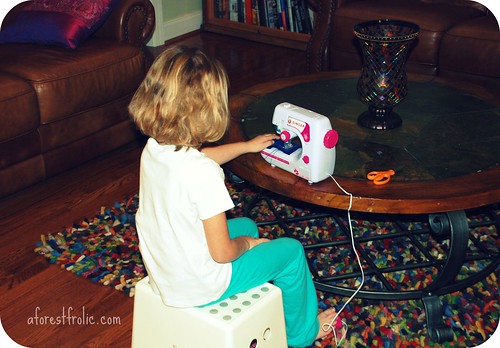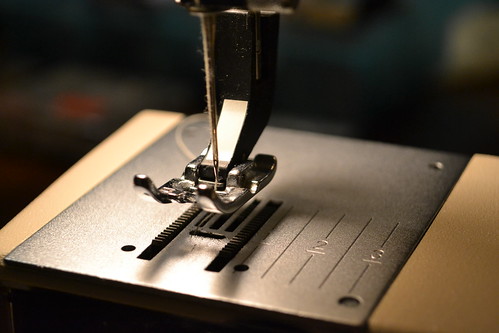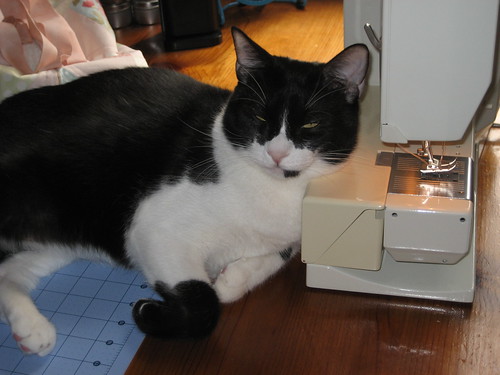
Image : http://www.flickr.com
You should clean your Singer Featherweight 221 at least once a year, and sometimes even after an extended period (several weeks) of continuous sewing.
Like any machine that needs to be cleaned and oiled, it's a good idea to work over a layer of newspapers in order to minimize any additional mess. Other items you'll need are a screwdriver, WD-40 lubricant, baby oil, sewing machine oil, lint free cotton fabric, Q-tips or toothpicks, an old small head toothbrush, and possibly 0000 fine steel wool and kerosene. Do not use alcohol (or Lestoil) to clean your Featherweight as it will dissolve the finish and the machines decals.
Start by scraping off all visible grease with a lint free cotton fabric. If you have not cleaned your Featherweight in some time, or you just purchased one and this is its first cleaning in a while, you may need to dissolve some grease that has hardened. To do this pour a little kerosene (or WD-40) onto the solidified grease and allow it to soften. Very stubborn, hardened grease may need to be soaked overnight in which case you should tip your Featherweight so that the solid material sits on a cloth soaked with kerosene (naturally this should be done in a well ventilated area, and away from open flames). Once all the old grease is removed, reapply approved sewing machine oil only. Refer to your owner's manual for the appropriate oiling locations.
If you notice bits of grease or grime accumulating around the Singer Featherweight decal, or lettering, these can be easily removed with a Q-tip or toothpick covered with a small section of your lint free cotton. Stubborn bits can be removed by first soaking the end of the Q-tip with WD-40 or kerosene.
Remove the needle plate (throat plate) and remove any thread that may be wound around the shaft. Also clean out any accumulated lint inside the cover and under the thread spindle with a toothbrush.
If you are mechanically inclined, it's not a bad idea to give your Featherweight 221 a very thorough internal cleaning as well. This means having to remove pretty much every mechanical component that can be unscrewed including the face plate, presser foot, bobbin cover and flywheel, but not the motor. It's always a good idea to keep the components together (and labeled if necessary) so you know how to put it all back together again. All components should be thoroughly sprayed/soaked with WD-40 and wiped clean. The WD-40 will actually clean, lubricate, and help to protect the metal components.
Remember, although you can wipe down the motor housing, do not lubricate the motor. Electric motors require very little lubricant, and it is very easy to damage the motor by over lubricating it.
After you wipe down the motor, take a moment to check the belt tension. There should only be ½ to ¾ of an inch of play in the belt. Also, if the belt is worn, replace it. This is done by loosening the screw directly under the belt at the base of the machine, almost straight back from the light switch. Loosen the screw just enough so that the motor slides (do not remove the screw) and the belt is able to be removed. Place the new belt on, slide the motor back into position and retighten the screw. Make sure you have the proper belt tension. If the belt is too tight you will strain the motor. If the belt is too loose, you will lose power. To get the best performance out of your machine, take your time and make sure you have the proper belt tension.
If you notice any light surface rust (not deeply pitted) on the metal parts of your machine, this can also be fairly easily removed. Rub the rusted section gently with 0000 fine steel wool. Stubborn spots can be helped off by first spraying the steel wool with WD-40 or dabbing with kerosene. Do not use the steel wool to remove any dirt, grease or debris from the machine surface since it will leave scratch marks on the lacquer finish.
Once you've finished cleaning your Singer Featherweight 221, make sure all of the screws have been tightened. Any loose screws can cause grinding or rattling noises and in extreme cases can possibly damage you machine, if it causes a jam.
Finally, put a little dab of baby oil onto a soft lint free cotton fabric and rub it all over the outside of the machine body. Wipe off any excess. Not only will this give the unit a nice shine, but the oil will help to preserve the varnish finish.
Regular cleaning of your Singer Featherweight 221 sewing machine will keep it running smoothly for years.
If you liked this article and are looking for either more information or want to know where you can find one, visit the Featherweight 221 page of my blog.
Did you know that you can also save yourself quite a few dollars by learning how to repair your sewing machine at home.
Read More




